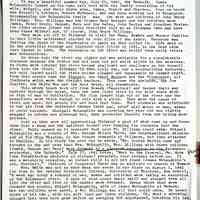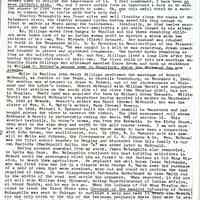Tragedy on the Kalamazoo River

2021.41.70
1830 Settlement, pioneer eraNautical
Winthers, Sally
2021.41
Schmiechen, James A.
Donation
TRAGEDY ON THE KALAMAZOO RIVER It was a beautiful summer day, July 25, 1841, the Sabbath. James McLaughlin loaded up his open sail boat with his family consisting of his wife, Abigail, and their three sons, James, Robert and Charles. Also on board was Abigail's brother, Robert McDonald, who had been working out at Singapore. Accompanying the McLaughlin family was the wife and children of John Henry Billings. Mrs. Billings was the former Mary Baragar and her children were James, Peter Henry, Hannah, Mary and the twins, John Darius and Jonathan Hosias. One other person joined the group described only as an Irishman (who may have been Oshea Wilder) and, of course, John Henry Billings. They were all off to Richmond to visit the Mann, Bowker and Meeker families in that little settlement started by John Allen of Ann Arbor. Everyone was feeling the pinch of the depression or panic as they called it. Life went on in the strictest economy and improved only little by 1841, In the dead calm that lasted to 1845. The excursion on the river was relief from daily trials and tribulations. In those days the river ran higher and was navigable for a considerable distance because the forest had not been cut yet which silted in the waterway. As farms were created the river became shallower and shallower as the topsoil blew into the river. Allegan, In that early day, had a boatbuilding industry, but only lasted until the river became clogged and impassable by larger craft. From that center came the Pioneer, the Great Western and the Tippecanoe, all flatboats which were the freight haulers. Then came the Adelaide, the Ira Chaffee, the Helen Mar and the Aunt Betsy, all steamboats. This merry bunch took off from Newark (Saugatuck) and tacked their way upriver through the marsh, then the tree lined river in its wild state with no sign of man or habitation. The fish jumped high out of the river and the mosquitoes were thick enough to stir with a stick. They were the cause of fever and ague, but people did not know that then. That sickness was attributed to bad air from the undrained swamps (mal= bad, aria= air) which no man, woman or child escaped. Abaigail McLaughlin was carrying her year old son tightly wrapped in cloths and although hot, they protected Charles from the biting mosquitoes. Just as they were all approaching Richmond a gust of wind came up and drove them into a snag and the sailboat turned over dumping its contents into the river. Panic ensued as it appeared that only Mr. Billings could swim. Abigail Mc Laughlin was a cousin of Mrs. George Nelson Smith, the Congregational missionary at Old Wing Mission, in the future township of Fillmore, but then attached to Manlius. In his diary the next day he wrote, "Mr. Josiah Martin came and brought us the sad news that Mrs. McLaughlin, Mrs. Billings with three children (James, Hannah and Mary) were drowned in a pleasure excursion in the Kalamazoo yesterday, the Sabbath." July 27, 1841 entry, "Went to the funeral, Mr. Hyde (the Presbyterian minister at Allegan) preached, four corpses before us. It was a melancholy occasion, an infant child is not yet found (James McLaughlin's son, Charles)." (Library of Congress) There was no minister or church at Newark Mrs. Smith was not as kind when she wrote in her diary on August 1, 1841 (on loan to the Bentley Historical Library, University of Michigan, Ann Arbor), "A week ago today a company of men, women and children were taking an excursion up the Kalamazoo river. A gale of wind upset their skiff and plunged them all into the river and five of the number were drowned. Among those that were drowned was cousin, Abigail McLaughlin, wife of James McLaughlin at Newark. Her two children were saved, a Mr. Billings was all that could swim. He saved three of his own , with his wife lost and three children. Oh, what a shocking thought that they have gone before an avenging God unprepared, breaking his law, pleasing themselves, heaping up wrath against the day of wrath. When will man be wise and think on the latter and how long will little children have to suffer for the sins of their parents instead of being trained up in the way they should go? They go on and on from one sin to another until their doom is sealed for eternity. Abigail would have been an interesting woman if Christianity had beer her ruling principle, but instead of that, her selfish and uncontrolled passion which, even like many waters let loose, made her an unhappy woman often in her family. She had been a professor of religion, was anxious to have meetings and seemed open to realize the importance of it. I feel condemned, I have been no more faithful with. Oh, may I never shrink from so important a duty as to warn the sinner to flee from teh wrath to come. Oh, may this awful event be a warning to others not to trifle with God's holy day." Charles McLaughlin was found alive and well floating along the banks of the Kalamazoo river, the tightly wrapped cloths having saved him long enough to float to safety as Moges among the bullrushes. Ironically, he died twelve year: later, at the age of thirteen after swallowing a pin which lodged in his airway. Mr. Billings moved from Ganges to Manlius and his three remaining children were taken care of by an Indian woman until he married a widow with two children of her own, Mrs. Miranda (Clark) Leonard. Her husband was crushed to death in the Singapore mill. H. H. Hutchins in Recollections of the Pioneer, p. 9 recounts the event, "He was caught in a belt he was repairing, drawn upward and crushed to pieces and scattered fragments. The horrid marks remaining as long as the building stood." Mr. and Mrs. Billings lived a long life after that having thirteen children of their own. The first child of this new marriage was Charles Clark Billings who afterward married Clara Brown and took up residence in William G. Butler's second home in Saugatuck, where the Wickwood Inn now stands. While in Manlius John Henry Billings performed the marriage of Robert McDonald, as Justice of the Peace, to Cordelia Vradenburg, on November 6, 1842. The wedding was witnessed by Jesse W. Palmer, one of the storekeepers at Richmond and the bride's father. Robert McDonald with William Scovil are considerer the first settlers on the south side of the river (the Douglas side), but not in Douglas. Their land was acquired for them by Michael Brown Spencer. William Scovil was Robert McDonald's stepfather having married his mother on September 28, 1845 at Newark: Robert's mother was Nancy (Brown) McDonald, who was the sister of Mrs. G. N. Smith's mother, Mary (Brown) Powers. In 1846, Michael B. Spencer built the first sawmill in Saugatuck and had bought across the river to harvest the timber. The 1846 assessment roll shows McDonald & Scovil in partnership owning the whole NW 1/4 of section 16. This woodlot basically, in today's terms, ran from the Keewatin to the Kirby House, then west to the sign shop and north to the golf course creek. I am not sure how all the Brown's were connected, but there seems to have been a connection with John Brown, the abolitionist, too. By 1850, M. B. Spencer sold his sawmill to Wells and Johnson, the forerunners of O.R. Johnson & Co. Mrs. McDonald was the first school teacher in Douglas and descended from this family is our own Marjorie (MacDonald) Aplin; the "a" was added later to McDonald. Having strayed somewhat from my story, James McLaughlin also remarried, to Lydia Ann Case. Mr. McLaughlin continued his boat building activities in Newark until the government hired him as farmer to the Indians at Old Wing Mission, to teach them agriculture. He replaced the well known Isaac Fairbanks, who was fired from the job in a dispute with George N. Smith over the purchase of a pair of oxen that were strained, worn out and could not perform the task required of them. In the disagreement Fairbanks threatened to take Smith out in the middle of the road and settle the argument. When reported, it did not sit well with William Almy Richmond, Acting Superintendant of Indian Affairs, at Grand Rapids, and he was let go. When the Indians of Old Wing Mission decided to leave the Black River area (because of the massive infusion of Dutch) McLaughlin was sent to Chicago to purchase a ship and make it ready (In Newark) for the trip north to the tip of the Leelanau peninsula where they were to settle. He moved the mission on this ship in 1849, leaving Newark. He moved to Elk Rapids, Michigan in 1851 continuing his boat building operation after leaving the employment of the government with a change of administration. Newark Notes and Quotes From 150 Years Ago by Charles J. Lorenz, Copyright 1991
11 in
8-1/2 in
175 Butler & 1830s Settlers
McLaughlin, James 1789-1863Billings, John Henry 1811-1874New Richmond/RichmondSpencer, Michael B. 1820-1891Scoville, William 1783-1860McDonald, Robert A. 1820-1889Smith, George Nelson Sr. 1807-1881Smith, Arvilla Almira (Powers) 1808-1895
10/22/2025
10/22/2025


